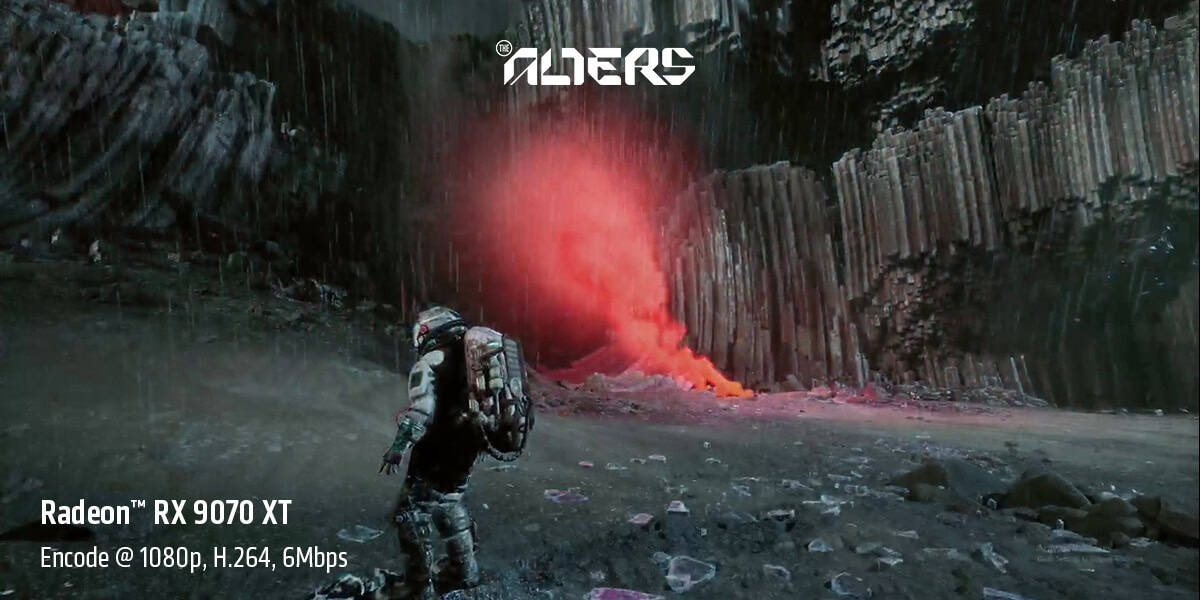AMD is making waves in the GPU market with their latest announcement. During a recent live stream, the company teased that RX 9060 products will be coming in Q2 2025 to expand their 9000 series lineup. AMD plans to “broaden the family even further” with these new graphics cards, signaling their commitment to offering more options at different price points.
The announcement was brief, with AMD noting that full details about the RX 9060 products will be “coming later.” This strategic move comes as the company continues to challenge competitors in the mid-range GPU segment, where price-to-performance ratio is crucial for many gamers and content creators.

AMD Prepares to Shake Up the Mid-Range GPU Market
AMD is gearing up to expand its Radeon RX 9000 Series with the introduction of the RX 9060 lineup, expected to launch in Q2 2025. This announcement signals AMD’s continued push into the competitive GPU market, offering more affordable, yet powerful options for gamers who don’t need the raw horsepower of the RX 9070 XT and RX 9070 but still want the benefits of RDNA 4 architecture.
What to Expect from the RX 9060 Series
While AMD has yet to reveal full specifications, we can make some educated guesses based on the company’s strategy and past releases:
- Optimized Performance: The RX 9060 series is likely to feature a cut-down version of RDNA 4, retaining AI-powered FidelityFX Super Resolution 4 (FSR 4), third-generation ray tracing, and HYPR-RX enhancements but with fewer compute units and lower power draw than the RX 9070 series.
- Memory Configuration: Expect a 12GB or 16GB GDDR6 variant on a 192-bit or 256-bit memory bus, balancing cost and performance while ensuring high frame rates at 1440p and 1080p resolutions.
- Lower Power Consumption: One of RDNA 4’s strengths is power efficiency, so the RX 9060 series will likely have a total board power (TBP) between 150W and 200W, making it a great fit for smaller cases and lower-wattage power supplies.
- Competitive Pricing: Positioned below the RX 9070 XT ($599) and RX 9070 ($549), the RX 9060 XT and RX 9060 will likely retail between $349 and $449, directly competing with NVIDIA’s rumored RTX 5060 lineup.
RDNA 4 Brings AI-Powered Upscaling and Next-Gen Ray Tracing
Even though the RX 9060 series will be a mid-range offering, it won’t skimp on next-gen features. AMD’s FidelityFX Super Resolution 4 (FSR 4) will bring AI-powered image upscaling to boost frame rates while maintaining high image quality, making 4K gaming more accessible even on mid-tier hardware.
Additionally, the third-generation ray tracing accelerators in RDNA 4 promise to significantly improve lighting, reflections, and shadows, making games look more immersive than ever before. With over 2x the ray tracing throughput per compute unit compared to RDNA 3, AMD is closing the gap with NVIDIA’s RTX series, which has long dominated in this area.
How the RX 9060 Series Will Impact the GPU Market
AMD’s mid-range offerings have historically been some of the best bang-for-your-buck options, and the RX 9060 lineup looks to continue that tradition. Here’s why it matters:
- More Affordable Gaming: The RX 9060 series will likely target 1080p and 1440p gamers, delivering high frame rates with modern features at a reasonable price.
- A True Alternative to NVIDIA: With better power efficiency, competitive pricing, and AI-driven performance enhancements, AMD is poised to challenge NVIDIA’s dominance in the mid-range market.
- Great for Budget Builds and Upgrades: The RX 9060 series is expected to work well without requiring expensive power supplies or high-end cooling solutions, making it an attractive option for budget-conscious builders and those looking to upgrade from older GPUs like the RX 6600 or RTX 3060.
Will AMD Undercut NVIDIA in Price-to-Performance?
If AMD aggressively prices the RX 9060 lineup, it could capture a massive share of the mid-range market, especially if NVIDIA sticks to its historically higher pricing strategies. With FSR 4, better ray tracing, and AI-powered performance boosts, AMD is sending a strong message: next-gen gaming doesn’t have to break the bank.
Final Thoughts: Should You Wait for the RX 9060 Series?
If you’re considering a GPU upgrade and currently using an older RX 6000 Series or RTX 3000 Series card, waiting for the RX 9060 could be a smart move. With next-gen technology, lower power consumption, and AI-driven performance enhancements, it promises to be one of AMD’s most exciting mid-range releases in years.
With the RX 9060 lineup expected in Q2 2025, we won’t have to wait long to see how well AMD delivers on its promises. Whether you’re a competitive gamer or just looking for a great all-around graphics card, the RX 9060 Series could be the best value in 2025’s GPU market.
Key Takeaways
- AMD will launch RX 9060 products in Q2 2025 to expand their 9000 series GPU lineup.
- The company promises to share complete specifications and pricing details in upcoming announcements.
- These new graphics cards aim to give users more affordable options while maintaining the performance standards of the 9000 series.
AMD’s RX 9060 Series Expansion
AMD is set to grow its graphics card lineup with new mid-range options in the coming months. The expansion targets mainstream gamers who want solid performance without premium pricing.
Q2 2025 Release Strategy
AMD has confirmed its RX 9060 products will launch in Q2 2025. This strategic timing places these new cards in the market just before summer, when gaming activity typically increases.
The company plans a staggered release approach. Initial models will appear in April, followed by additional variants through June. This method helps AMD maintain media attention throughout the quarter.
Pricing is expected to be competitive, with the base RX 9060 likely positioned between $299-349. Higher-tier models with increased VRAM or factory overclocks may reach the $399 mark.
Retailers have already been briefed on inventory expectations. AMD aims to avoid the supply shortages that plagued previous GPU launches.
Advancing the 9000 Series GPU Lineup
The RX 9060 cards will fill an important gap in AMD’s current 9000 series portfolio. These new products will sit between the entry-level RX 9050 and the more powerful RX 9070.
Technical specifications hint at 8GB GDDR6 memory on a 128-bit bus for standard models. Higher-end variants may offer 12GB options to better handle modern game requirements.
Power efficiency looks promising. AMD’s representatives mentioned improved performance-per-watt metrics compared to previous generations, with most models requiring only a single 8-pin power connector.
The cards will support all current AMD features including FSR 3.0 upscaling technology. This helps boost frame rates in demanding games without sacrificing much visual quality.
Driver support is also being enhanced for these new cards. AMD plans to release optimized drivers specifically tuned for popular titles launching alongside the RX 9060 series.
Live Stream Announcement Insights
AMD revealed exciting details about their upcoming RX 9060 graphics cards during their recent presentation, confirming Q2 2025 release plans and hinting at strategic market positioning for budget-conscious gamers.
Overview of New Product Features
The AMD RX 9060 will join the existing 9000 series lineup as a more affordable option while maintaining key next-gen features. During the stream, AMD executives highlighted that these new cards will support the latest RDNA 4 architecture, bringing improved power efficiency and better ray tracing capabilities to lower price points.
The presentation confirmed that the RX 9060 will include:
- 8GB GDDR6 memory on a 128-bit bus
- Hardware ray tracing acceleration
- AI-powered FSR 4.0 upscaling technology
- Up to 30% better performance than previous generation equivalents
AMD also teased enhanced video encoding capabilities and optimized driver support for popular titles. The company plans to offer both reference designs and partner custom models at launch, giving consumers various cooling and aesthetic options.
Anticipated Impact on the GPU Market
The RX 9060 announcement represents AMD’s strategic move to challenge NVIDIA’s dominance in the mid-range segment. Industry analysts expect these new GPUs to be priced competitively between $279-329, targeting the sweet spot for mainstream gamers unwilling to spend on premium options.
This timing is particularly noteworthy as it comes just as many gamers on older hardware are looking to upgrade. The RX 9060 could significantly disrupt the market by offering:
- More affordable entry points to modern gaming features
- Better value compared to competing products
- Increased pressure on NVIDIA to adjust their pricing strategy
Early benchmark hints suggest the RX 9060 will deliver performance comparable to higher-tier cards from previous generations. Retailers are already preparing shelf space for what could be a high-demand product upon release.
The cryptocurrency mining impact appears minimal this time, as AMD has implemented measures to make these cards less appealing for mining operations while optimizing gaming workloads.
Frequently Asked Questions
AMD’s upcoming RX 9060 GPU series has sparked interest among gamers and professionals alike. Many questions remain about performance capabilities, power efficiency, and feature support as we await full details expected later in 2025.
What are the expected performance improvements of the RX 9060 series over the previous generation?
While AMD hasn’t released specific benchmarks yet, industry analysts predict the RX 9060 series could offer 15-20% better performance than the previous RX 7600 cards. This jump would put the cards in a sweet spot for 1080p gaming with high refresh rates.
The new RDNA 4 architecture likely brings improved compute units that handle modern games more efficiently. Early rumors suggest better 1440p performance too, potentially making this a versatile mid-range option.
How does the RX 9060 series aim to enhance gaming and professional workloads?
The RX 9060 will likely feature AMD’s updated FSR technology, improving frame rates across a wide range of games without quality loss. This makes high-end gaming more accessible on mid-range hardware.
For professional tasks, the cards may include optimized compute performance for content creation. Video editing and 3D modeling applications should see notable speed improvements over previous generations.
AMD also appears to be focusing on better driver support for creative applications, addressing a historical weak point compared to competitors.
What are the power efficiency metrics for the new AMD RX 9060 GPUs?
AMD is expected to maintain their focus on power efficiency with the 9060 series. Preliminary reports suggest TDP ratings between 130-150W, offering good performance per watt metrics.
This efficiency improvement stems from both architectural enhancements and refined manufacturing processes. The cards should run cooler than previous generations while delivering better performance.
Home builders and system integrators will appreciate these efficiency gains for easier thermal management and lower power demands.
Will the RX 9060 products support ray tracing and other next-gen graphics features?
Yes, the RX 9060 series will support ray tracing with AMD’s second-generation ray accelerators. These hardware components have been improved to better handle light calculations in modern games.
AMD is also expected to include AI-powered upscaling features similar to their competitors. This combination of ray tracing and AI upscaling should provide excellent visual fidelity at playable frame rates.
The cards will likely support the latest DirectX and Vulkan APIs for maximum game compatibility.
Can we expect a new tier of VRAM capacities with the RX 9060 GPUs?
AMD might increase the baseline VRAM configuration to 12GB for the RX 9060 series, up from 8GB in previous generations. This boost would help with texture-heavy games and future-proof the cards.
The memory interface will likely see improvements too, with faster GDDR6 modules and possibly wider bus widths. Higher memory bandwidth directly translates to better gaming performance at higher resolutions.
Different models in the series might offer varied VRAM configurations to hit multiple price points.
Has AMD announced the pricing range for the RX 9060 series?
AMD hasn’t revealed official pricing yet, but market analysts expect the RX 9060 to target the $300-350 range. This would position it competitively against similar offerings from other manufacturers.
Supply chains have improved since previous launches, which should help AMD maintain better stock levels and more stable pricing. Regional pricing differences will likely follow typical patterns based on taxes and import fees.
Pre-order opportunities might appear closer to the Q2 2025 launch window, giving eager buyers a chance to secure their cards early.







